Meiji Memorial Picture Gallery
Meiji Memorial Picture Gallery (聖徳記念絵画館, Seitoku Kinen Kaigakan) opened in Tokyo, Japan, in 1926. In June 2011, the Gallery was designated an Important Cultural Property. Inside are eighty paintings depicting events from the life of Emperor Meiji, by forty leading nihonga and forty leading yōga artists.[1][2][3]
| Meiji Memorial Picture Gallery | |
|---|---|
聖徳記念絵画館 | |
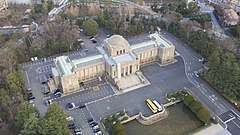 | |
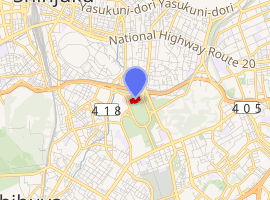
| |
| General information | |
| Address | 1-1 Kasumigaoka-machi |
| Town or city | Shinjuku, Tokyo |
| Country | Japan |
| Coordinates | 35°40′44″N 139°43′04″E |
| Opened | 1926 |
| Website | |
| Official website | |
Wall art collections are displayed to show the events from the birth to the demise of the Meij'i Emperor in chronological order, with the titles of the works representing the events. The first 40 works are Japanese-style paintings, while the later 40 are Western-style works. The pictures, each measuring about 3m x 2.7m.[4]
The building was designed by architect Masatsugu Kobayashi and completed on 22 October 1926.[5] Kobayashi's design was chosen from 156 entries in a public design competition held in 1918. His original drawing was modified by Meijijingu Zoeikyoku (building department).[4]
| Painting | Date of event | Painter | Dedication of painting | Comments | Image | Dedicator | |
|---|---|---|---|---|---|---|---|
| 1 | The Birth of Emperor Meiji 御降誕 Go-kōtan | 3 November 1852 | Takahashi Shūka (高橋秋華) (1877–1953) | July 1930 | depicted is the Lying-in Chamber (御産室) erected by Nakayama Tadayasu in the grounds of Kyoto Imperial Palace | .jpg) | Marquis Nakayama Sukechika (中山輔親) |
| 2 | The Rites of Growth 御深曾木 On-fukasogi | 6 May 1860 | Kitano Tsunetomi (北野恒富) (1880–1947) | November 1934 | ceremonial trimming of the hair, performed by Ichijō Tadaka (一条忠香) in the Omima | .jpg) | Baron Kōnoike Zenemon (鴻池善右衛門) |
| 3 | Investiture of the Crown Prince 立親王宣下 Ritsu shinnō senge | 10 November 1860 | Hashimoto Eihō (橋本永邦) (1886–1944) | June 1931 | Nijō Nariyuki presents the imperial proclamation at the Palace | .jpg) | Mitsubishi Gōshi gaisha |
| 4 | Accession to the Throne 践祚 Senso | 13 February 1867 | Kawasaki Shōko (川崎小虎) (1886–1977) | August 1930 | the Emperor, aged fifteen, appointed Nijō Nariyuki as regent in the Seiryōden on the day of his accession | Marquis Ikeda Nobumasa (池田宣政) | |
| 5 | Resignation of the Last Shōgun 大政奉還 Taisei hōkan | 7 November 1867 | Murata Tanryō (邨田丹陵) (1872–1940) | October 1935 | Tokugawa Yoshinobu informs officials of his decision at Nijō-jō | 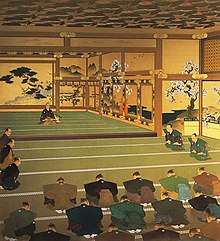 | Prince Tokugawa Yoshimitsu (徳川慶光) |
| 6 | Restoration of Imperial Rule 王政復古 Ōsei-fukko | 3 January 1868 | Shimada Bokusen (島田墨仙) (1867–1943) | March 1931 | the Emperor abolishes the offices of Sesshō, Kampaku, and Shōgun | .jpg) | Marquis Matsudaira Yasutaka (松平康荘) |
| 7 | The Battles of Toba and Fushimi 伏見鳥羽戦 Fushimi-Toba-sen | 29 January 1868 | Matsubayashi Keigetsu (松林桂月) (1876–1963) | July 1933 | .jpg) | Prince Mōri Motoaki (毛利元昭) | |
| 8 | Attainment of Majority Ceremony 御元服 Go-genpuku | 8 February 1868 | Itō Kōun (伊東紅雲) (1880–1939) | November 1928 | held shortly after the Emperor turned 16; his hairstyle was changed, he donned the robes of manhood, and he was crowned by Prince Fushimi Kuniie | .jpg) | Prince Konoe Fumimaro |
| 9 | The Emperor's Visit to the Dajōkan 二条城太政宮代行幸 Nijō-jō Dakōjan dai-gyōkō | 25 February 1868 | Kobori Tomoto (小堀鞆音) (1864–1931) | April 1933 | the Emperor was conveyed to Nijō-jō by palanquin | .jpg) | Baron Mitsui Hachirōemon |
| 10 | The Imperial Army Leaves Kyōto 大総督熾仁親王京都進発 Dai-sōtoku Taruhito shinnō Kyōto shinpatsu | 8 March 1868 | Takatori Wakanari (高取稚成) (1867–1935) | September 1931 | Prince Arisugawa Taruhito salutes the Emperor in front of the Kenreimon before setting out for Edo | .jpg) | Marquis Hachisuka Masaaki (蜂須賀正韶) |
| 11 | The Emperor Receives Foreign Ministers 各国公使召見 Kakkoku kōshi shōken | 23 March 1868 | Hiroshima Kōho (広島晃甫) (1889–1951) | November 1930 | the Emperor receives Dirk de Graeff van Polsbroek; to the left and right of the imperial dais are Prince Yamashina Akira and Iwakura Tomomi | .jpg) | Marquis Date Muneharu (伊達宗彰) |
| 12 | Proclamation of the Imperial Oath 五箇條御誓文 Gokajō no go-seimon | 6 April 1868 | Inui Nanyō (乾南陽) (1870–1940) | April 1928 | Sanjō Sanetomi reads the Oath in Five Articles | .jpg) | Marquis Yamauchi Toyokage (山内豊景) |
| 13 | The Surrender of Yedo Castle 江戸開城談判 Edo kaijō danpan | 6 April 1868 | Yūki Somei (結城素明) (1875–1957) | December 1935 | Saigō Takamori and Katsu Kaishū negotiate the surrender without bloodshed of Edo Castle | .jpg) | Marquis Saigō Michinosuke (西郷吉之助), Count Katsu Kuwashi (勝精) |
| 14 | The Emperor Reviewing Clan Warships 大阪行幸諸藩軍艦御覧 Ōsaka gyōkō shohan gunkan goran | 18 April 1868 | Okada Saburōsuke (1869–1939) | April 1936 | in Ōsaka Bay | .jpg) | Marquis Nabeshima Naomitsu (鍋島直映) |
| 15 | Enthronement of the Emperor 即位礼 Sokui no rei | 12 October 1868 | Igai Shōkoku (猪飼嘯谷) (1881–1939) | December 1934 | in the grounds of Kyōto Imperial Palace | .jpg) | Kyōto City |
| 16 | The Emperor Viewing Rice Harvest 農民収穫御覧 Nōmin shūkaku goran | 11 November 1868 | Morimura Gitō (森村宜稲) (1872–1938) | August 1930 | in Hatchōnowate (八丁畷), Owari Province, while en route to Tōkyō | .jpg) | Marquis Tokugawa Yoshichika (徳川義親) |
| 17 | The Emperor Arriving in Tōkyō 東京御着輦 Tōkyō go-chakuren | 26 November 1868 | Kobori Tomoto (小堀鞆音) (1864–1931) | October 1934 | arrival at Edo Castle | .jpg) | Tōkyō City |
| 18 | Installation of the Empress 皇后冊立 Kōgō no sakuritsu | 9 February 1869 | Suga Tatehiko (菅楯彦) (1878–1963) | December 1935 | Princess Haruko arrived at the Kyōto Imperial Palace in the traditional ox-cart | .jpg) | Ōsaka City |
| 19 | The Emperor at the Grand Shrine of Ise 神宮親謁 Jingū shinetsu | 23 April 1869 | Matsuoka Eikyū (松岡映丘) (1881–1938) | April 1927 | the Emperor left Kyōto for Tōkyō for the second time on 8 April 1869, stopping en route at Ise Jingū | 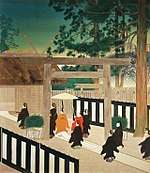 | Marquis Ikeda Nakahiro (池田仲博) |
| 20 | The End of the Feudal Clans 廃藩置県 Haihan chiken | 29 August 1871 | Kobori Tomoto (小堀鞆音) (1864–1931) | September 1931 | Sanjō Sanetomi reads the edict | 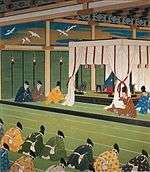 | Count Sakai Tadamasa (酒井忠正) |
| 21 | The Iwakura Mission to America and Europe 岩倉大使欧米派遣 Iwakura taishi Ōbei haken | 23 December 1871 | Yamaguchi Hōshun (1893–1971) | December 1934 | the party board the steamship SS America in the Port of Yokohama | Yokohama City | |
| 22 | The Great Imperial Thanksgiving Rite 大嘗祭 Daijōsai | 28 December 1871 | Maeda Seison (1885–1977) | July 1933 | performed once by each emperor; the Emperor offers up newly harvested rice and sake | Count Kamei Koretsune (亀井茲常) | |
| 73 | The Triumphal Grand Naval Review 凱旋観艦式 Gaisen kankan shiki | 23 October 1905 | Tōjō Shōtarō (東城鉦太郎) (1865–1929) | May 1929 | the Emperor aboard the Asama reviews the Combined Fleet in Yokohama Bay on 23 October 1905, with Commander-in-Chief Tōgō Heihachirō to his left and the future Taishō Emperor to his right, flanked in turn by Navy Minister Yamamoto Gonnohyōe and Chief of the Navy General Staff Itō Sukeyuki; over 160 vessels took part in the 1905 Triumphal Grand Review that celebrated the navy's contribution to victory in the Russo-Japanese War | 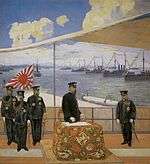 | Ministry of the Navy |
| 74 | The Triumphal Grand Army Review 凱旋観兵式 Gaisen kanbei shiki | 30 April 1906 | Kobayashi Mango (小林万吾) (1870–1947) | December 1931 | the Emperor reviews the troops at the Aoyama Parade Grounds (東京青山練兵場), with Ōyama Iwao riding behind | .jpg) | Ministry of the Army |
| 75 | Demarcation of the Sakhalin Frontier 樺太国境画定 Karafuto kokkyō kakutei | June 1906 | Yasuda Minoru (安田稔) | December 1932 | Japanese and Russian representatives designate the boundary marker | Nippon Oil Kabushiki gaisha | |
| 76 | The Chrysanthemum Garden Party 観菊会 Kangikukai | 19 November 1909 | Nakazawa Hiromitsu (中沢弘光) (1874–1964) | May 1931 | the Emperor and Empress attend the party at the Akasaka Palace for the first time | .jpg) | Marquis Tokugawa Yorisada (徳川頼貞) |
| 77 | The Union of Korea and Japan 日韓合邦 Nikkan gappō | 22 August 1910 | Tsuji Hisashi (辻永) (1884–1974) | October 1927 | depicted is the Namdaemun at the time of annexation | The Provinces of Korea | |
| 78 | The Emperor at Tokyo Imperial University 東京帝国大学行幸 Tōkyō Teikoku Daigaku gyōkō | 10 July 1912 | Fujishima Takeji (1867–1943) | April 1936 | the arrival of the Emperor for the graduation ceremonies | .jpg) | Marquis Maeda Toshinari |
| 79 | The Emperor's Final Illness 不豫 Fuyo | July 1912 | Tanabe Itaru (田辺至) (1886–1968) | March 1927 | as the Emperor's condition worsened, people gather outside the Tokyo Imperial Palace to pray for his recovery | Tōkyō Prefecture | |
| 80 | The Imperial Funeral 大葬 Taisō | 14 September 1912 | Wada Sanzō (1883–1967) | July 1933 | after a ceremony at the Aoyama Funeral Pavilion (青山葬場殿) in Tōkyō on 13 September, the Emperor's coffin was taken by train to Kyōto, before being conveyed to Fushimi Momoyama no Misasagi (伏見桃山陵) | .jpg) | Meiji Jingū Commemorative Association (明治神宮奉賛会) |
See also
References
| Wikimedia Commons has media related to Meiji Memorial Picture Gallery. |
- "Meiji Memorial Picture Gallery". Meiji Jingu Gaien. Retrieved 3 November 2015.
- 聖徳記念絵画館 [Meiji Memorial Picture Gallery] (in Japanese). Agency for Cultural Affairs. Retrieved 3 November 2015.
- Meiji Jingū Gaien, ed. (2001). 聖徳記念絵画館壁画 [Explanatory Notes on pictures in Memorial Picture Gallery, Meiji Jingū] (in Japanese).
- "MEIJIJINGU GAIEN|Meiji Memorial Picture Gallery". Meijijingugaien.jp. 1925-10-22. Retrieved 2019-03-20.
- "Meijijingu Gaien".
External links
- (in English) Meiji Memorial Picture Gallery
- (in Japanese) The Paintings